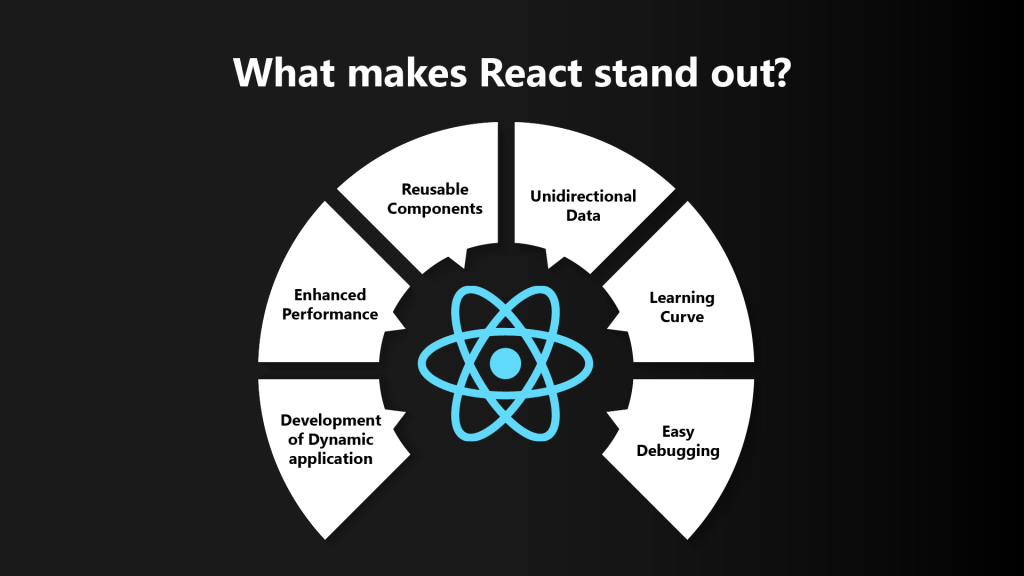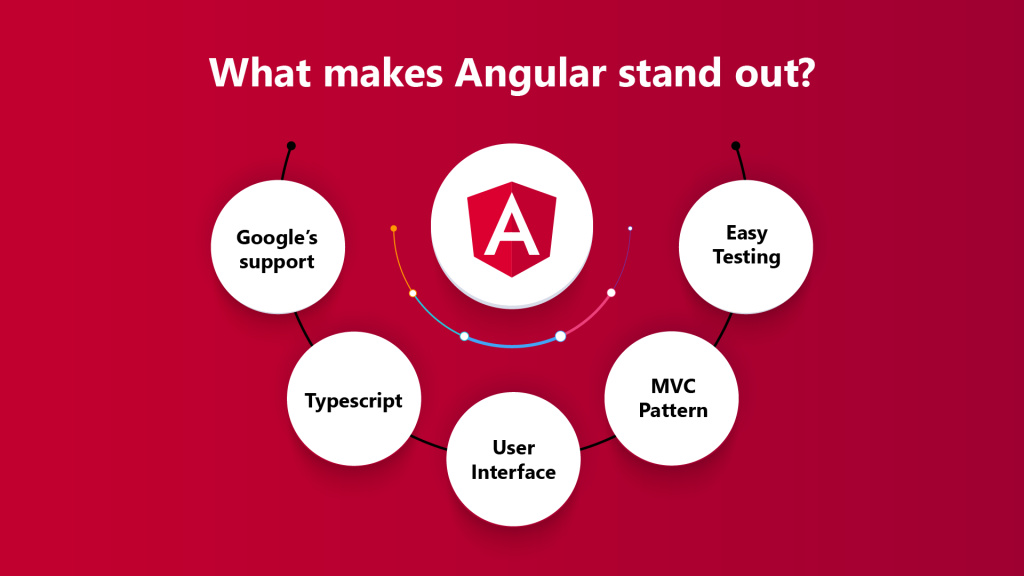The plethora of technologies sustaining the world of web and app development has made it hard to choose the best bet for web and app development.
In some ways, the most thriving technologies in the world of web development are Angular and React. The developers are more inclined toward making the best use of these technologies to develop applications, and hence the demand is exponentially escalating.
If you’ve stumbled upon the two and want to pick the best to ensure that you develop a highly functional and efficient application, it’s wise to evaluate both technologies so that you arrive at the decision to choose the best one for your next project.
This blog will shed some light on both Angular and React technologies and will help you evaluate all the parameters before jumping to conclusions.
What exactly is React?
React is an open-source library that’s developed by Facebook for web and app development.
The leverage of this technology over other frameworks is its insanely-used modular and coherent components, which have reusable components and lead to the quick development of applications.
The developers can easily reuse the logical part of an application, easily maintain the components, and enhance the performance of the application, making it stand out among other frameworks.
Undoubtedly, React has been dominating the market ever since its launch by Facebook due to its component-based architecture.
What makes React stand out?
1. Development of Dynamic applications
It’s relatively easier to develop applications with React due to a reduced requirement for coding while delivering enhanced functionality.
The functionality of React isn’t restricted to the development of web applications, it has got way more to offer such as its framework,
React Native is quite in-demand and a popular framework is used to develop stunning mobile applications.
2. Enhanced Performance
With the help of a virtual DOM, you can easily build web applications. The best part about the virtual DOM is that the items get updated in the real DOM without necessitating any change in the updation of components, unlike traditional web applications.
3. Reusable components
An application is made up of several components. React stands out here as well, as its components are the foundation of the application and have their controls and logic that can be reused in the application, resulting in a significant reduction of the application’s development time.

4. Unidirectional data
React works on a unidirectional flow where its data flows in a single direction, making it easier for the developers to debug errors and nitpick the problems faced when developing an application.
5. Learning curve
React is far easier to learn as it comprises javascript and HTML components in addition to some useful features. Once you’re well-versed with HTML and JavaScript, it wouldn’t take much time to get acquainted with React’s library.
6. Easy debugging
To ensure the easy debugging of code, Facebook had already released a Chrome extension for better debugging of applications that simplifies and boosts the process of debugging React-based web applications.
What exactly is Angular?
It’s an open-source framework that helps to develop applications. It’s written in typescript. The developers can easily develop large-size applications with it.
The best part about this framework is that it’s a JavaScript framework, and JavaScript is the most preferred client-side scripting programming language.
It enables developers to interact with a large number of Web pages and is ideal for developing applications. In fact, it’s quite simple to learn and use.
However, with an abundance of frameworks and libraries available, it gets difficult to find the right stack. If you’re looking to get your hands on the right front-end development technology, undeniably, Angular is the best!
What makes Angular stand out?
1. Google’s support
The most notable advantage of Angular is Google’s support that it has gotten. Google offers long-term support, which implies that it has plans to make the best use of this framework and diversify the framework more.
In fact, Google uses it for developing its applications too.
2. Typescript
Angular is written in typescript, which is a subset of JavaScript. The paramount advantage of typescript is that it has the advantage of enabling optimal code quality that aids in making applications more secure while detecting errors in coding and performing maintenance operations.
3. User Interface
The user interface of Angular applications is created with HTML which is an easy-to-use programming language where you don’t have to invest time in creating program flows and can rather count on Angular to decide which item should be first.
Undoubtedly, HTML is a basic programming and declarative language comprising directives such as ng-model and ng-app.

4. MVC pattern
Angular is integrated with a model-view-controller, or MVC, system. It’s relatively similar to the model view-view controller, or MVVM, architectural system. However, it doesn’t require developers to divide applications into various MVC components and can rather write the codes to better connect.
Angular makes efficient use of MVVM by enabling bidirectional data binding in the model and offering the automatic propagation of the view model state. The view model accesses the observer model to inform it of changes, if any, made to the view model.
5. Easy testing
The components of an angular begin at the same time. For instance, each component enters its code into the component class or has metadata. It comprises small interface elements, which aren’t correlated with each other.
Which is the best bet for app and web development?
If you’re stuck between the two technologies and want to ensure that you end up using the right one for app development, here are certain parameters that can help you assess the best among the two:
1. In-demand popularity
When it comes to gauging the demand for both technologies, Google Trends is the best platform to compare the search lists of these frameworks.
It throws in some insights into the percentage of people who’re actively searching for these technologies.
The blue line in the graph shows the number of people who have searched “react” in the past twelve months, and the red line below shows the number of people who have searched for “angular” in the past twelve months.
It’s quite evident that there are a whopping number of people who’ve searched for React than Angular.

.

If we observe the stats of Stack Overflow, it’s evident that Reactsurpasses each technology to hit the top.
In addition, the community group of React is enormously larger than Angular as more developers actively work on a large number of projects of React than Angular.
2. Learning Curve
The learning curve of any technology reveals a lot about how easy it is for any developer to learn and make the best use of technology.
It’s paramount when developing larger-size applications as it would require a significant amount of coding.
Angular is relatively more difficult to learn and be proficient in than React. You must be well-versed with the basic concepts of templates, directives, modules, and services.
However, once you imbibe sufficient insights from them, you’re good to go ahead with more advanced concepts such as Rx.Js, AoT compilation, and many more.
React, on the flip side, requires a basic understanding of JSX, writing components, configuring, managing internal states, using routing libraries, and using stats management libraries such as MobX.
3. Best speed and productivity
The command line interface, or CLI, of Angular, offers an incredible workspace and development environment that enables the instant design of components with the use of a few codes.
Also, the abundance of built-in processes can instantly solve problems.
On the contrary, the third-party libraries of React have a direct influence on the productivity of React, as React involves a host of tools.
If a developer has to use an app for the update, it will end up consuming more time.
4. Components
Angular comprises three layers: models, views, and controllers, which have a complex yet fixed structure.
The developers have to use distinct files for distinct codes to make it quite easy to reuse the codes.
On the flip side, the React library doesn’t work with the code format and is rather more structured, where the component trees allow the code to be more logically structured and end up making component declarations more declarative.
5. Best Performance
The performance of the technology is always considered a crucial factor when deriving the best conclusion.
The document object model, or DOM, helps it better analyze the performance of technologies. The document object model is a programming interface that places XML, HTML, and XHTML into trees, which in turn enables scripts to interact with each other in real time.
Hence, it’s essential to consider DOM. In Angular, the real DOM is used to develop single-page applications in which the entire data structure is updated regularly regardless of alterations made.
It ends up slowing down the Angular-based app due to its extensive library.
For instance, Upwork, which uses Angular, is considered one of the most popular and in-demand Angular apps. Its user feed doesn’t have to be updated frequently.
On the flip side, React uses a virtual DOM, which is best to develop pages that require frequent updates.
Its library isn’t extensive and is small and dynamic, which makes it more efficient in performance. The performance of React-based applications is far better than Angular.
For instance, Instagram uses React as it requires frequent user feed updates.
6. UI and UX
The user interface is undeniably an important aspect to consider in an application.
Angular includes a material technology stack, which makes UI configuration much easier and faster.
On the flip side, React has its own extensive and awesome UI tools that help to develop appealing user interfaces for applications.
Also, there’s an abundance of free and paid UI tools that you can make the most of.
However, the new and updated versions of Angular have created stiff competition between the two technologies in their UI components
7. Easy updation
The command-line interface in Angular involves ng updates. It ends up making it relatively easier to update Angular-based applications.
Also, the updating procedure is automated.
On the flip side, in React there are two versions: one where the front-end is extensively dependent on external libraries for updates and one where it enables updates from third-party elements.
In addition, the developers have to put in much effort to use third-party libraries compatible with the JS version. It becomes a tad tedious process.
Here are a few other key metrics that you consider for better distinction:
Here are a few other key metrics that you consider for better distinction:
| Metrics | Angular | React |
| Language | It’s written in TypeScript, which is a subset of the Javascript language. | It’s written in JavaScript. |
| Usability | It’s a framework that works on real DOM that’s concerned more with application development and small libraries that facilitate the development of applications. | It’s a full-fledged JavaScript library that’s more inclined towards its UI components. It employs a virtual DOM and works with unidirectional data flow. |
| Best use | It’s more platform-oriented and is generally preferred to work with HTML apps that are highly compatible with other browsers. | Most companies prefer to develop dynamic applications as it is more reliable due to its programming language, Javascript making an edge. |
| Data Binding | Angular supports both two-way and one-way data binding, where it either modifies the user input to change the model state or can conversely change the model state for UI input. | It supports one-way data binding. |
| Dependency injection | It employs the hierarchical dependency injection system. | It doesn’t employ any dependency injection systems. |
| Prominent applications | YouTube, Upwork | Instagram, Twitter |
How does React outperform Angular?
The best part about React is its virtual DOM that stands tall. It uses a virtual DOM and optimizes rendering.
In addition, it makes it much simpler to effortlessly switch between its different versions.
Also, the React community is quite large and supportive and offers endless solutions for developers. It’s best for developers to reach out to the community in a quick go.
When it comes to seamless development of applications, it’s best to develop both cross-platform and single-page applications.
The developers can easily develop applications with a bunch of modern capabilities in just a span of time, which can even be used to personalize the web pages by making the most of it.
Conclusion
The popularity of React and Angular has spiked in recent years due to their outstanding performance and features.
There’s fierce competition between them, and it is always hard to pick one.
Hence, it depends on the project requirements and the kind of application you want to get developed, as Angular is a framework while React is a library and a great tool to develop simple applications in a short time while delivering great performance!




